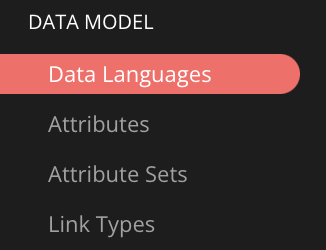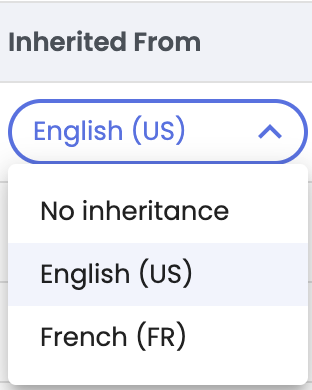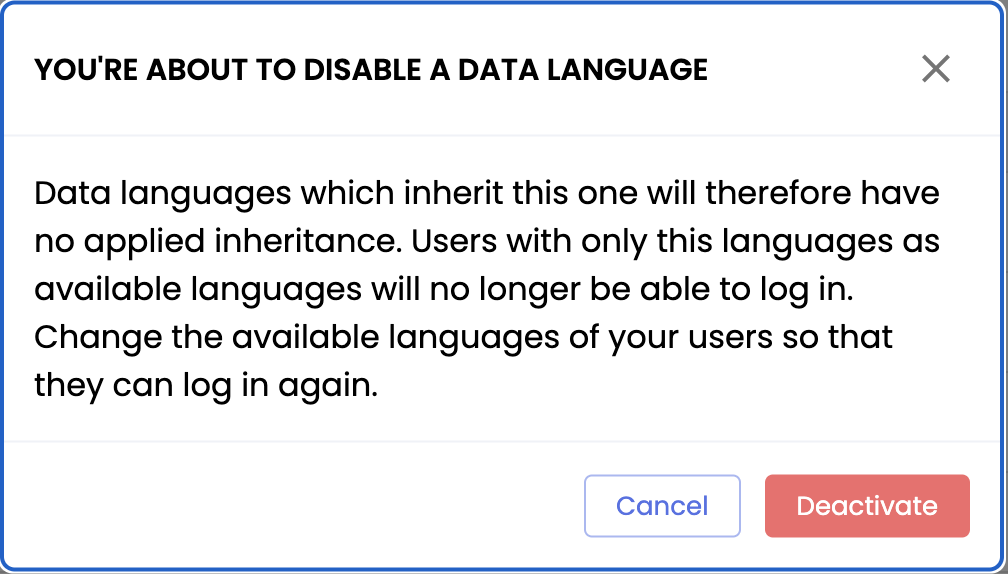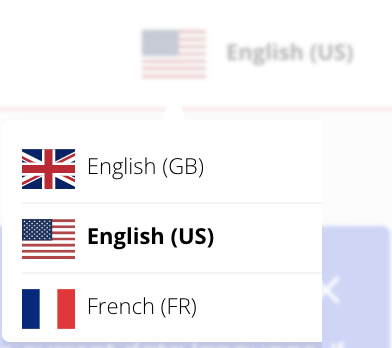Configuring Data Languages
Learning Objectives
- Understand the difference between interface language and data language
- Learn how to activate data languages and configure language inheritance
- Assign data languages to users.
Overview
Data languages allow you to manage and display data in different translations. They determine the language used for product attributes, variants, and assets.
Good to knowYou can activate as many data languages as needed. However, the number of included languages depends on the contract and plan you have with Quable.
Any exceeding languages may incur additional costs. For more information, contact your CSM.
Difference Between Interface Language and Data Language
Before starting, it's important to distinguish between two types of languages:
- Interface Language: Refers to the language used for displaying the PIM (menus, buttons, alert messages, etc.),
- Data Language: Also called locale, it refers to the language of product information.
These settings are independent. A user can:
- Work on product sheets in French (data language),
- Add translations in Spanish (data language),
- Use an interface in English (interface language).
- Understanding Locales: A locale is a linguistic variant that considers the specificities of a country. For example, Quable PIM distinguishes:
| Language | Locale (code) | Attribute Example |
|---|---|---|
| English (GB) | en_GB | Colour / Organise |
| English (US) | en_US | Color / Organize |
Managing locales allows you to tailor the distribution of product sheets to regional and linguistic differences in the markets where products are sold.
Good to knowFor more in-depth information about data languages, visit the Data Languages page of the Quable functional documentation.
Configure Data Languages
- From the administration menu, go to Data Model > Data Languages.

- You will access the list of activated and available languages.
Use the search bar to quickly find a locale.
Good to knowA banner will appear to inform you of the number of activated data languages. You will immediately be notified if the number exceeds the limit defined by your subscription.
Activate a New Data Language
- Search for the desired locale.
- Activate it by clicking the toggle button in the Active column.
- A confirmation will appear, and the language will become available.
Good to knowActivating a language adds columns in import/export templates. Ensure that this is compatible with your processes and data flows.
Set Language Inheritance
Inheritance allows you to display a default translation when a data language does not contain information.
- In the Inherited From column, select a fallback locale.

- A confirmation will appear, and the configuration will be saved.
Example: If an attribute does not have a value in English (GB), it will automatically use the value in English (US).
Disable a Data Language
- Click the toggle button to deactivate a language.
- A warning message will appear. Click Deactivate to confirm.

- The language becomes inactive but remains in the historical data.
A deactivated language is removed from import profiles, user permissions, and existing configurations.
Good to know
- Deactivating a data language does not remove the associated information. If the locale is reactivated, the data will be available again.
- If a deactivated data language is a source of inheritance for other languages, these will become inaccessible to users.
- It is not possible to deactivate a data language if it is the only one configured for a user. In this case, an error message will appear with the user's name.
Assign Languages to Users
A data language must be activated and assigned to users in order for them to access and use it.
- Go to Settings > Users.
- Select the concerned user.
- Add the language in the Available Languages section.
See the Training Hub course: Configure User Languages
Users can then select the active data language via the flag icon at the top right of the interface.

In SummaryData Languages vs. Interface Language
- The interface language concerns the display of the PIM, while the data language determines the language of product attributes. These settings are independent.
- Locale: It’s a linguistic variant specific to a country (e.g., en_GB for British English, en_US for American English).
Activate Data Languages
- Go to Data Model > Data Languages.
- Activate a language using the toggle button.
- Set language inheritance: A language can inherit from another to display a default value when no translation is available.
Deactivating a Language: Removes the language from existing configurations. Upon reactivation, the data becomes available again.
Assigning to Users: An activated language must be added in user settings to be accessible.
Next Chapter
Now that you know how to configure data languages, let's discover how to Create and Manage the Structure of Product Sheets.
Updated 3 months ago


